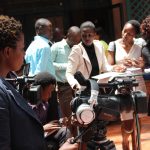Kenya’s economy expanded at the slowest pace since 2011 last year, as drought and the impact of a protracted election undermined growth.
Gross domestic product increased 4.9%, down from 5.85% in 2016, the Kenya National Bureau of Statistics said Wednesday. The government was forced to revise its projection downward three times from an initial forecast of 6% growth.
“The slowdown was driven by the electioneering period, drought and slowed uptake of credit by the private sector,” KNBS Director-General Zachary Mwangi told reporters in Nairobi during the release of the Economic Outlook Report 2018.
Kenya held two presidential elections last year after the first one was disputed by the opposition and then annulled by the Supreme Court. The State spent Ksh 54.1 billion ($541 million) on the August and October votes, during which dozens of people lost their lives in ensuing violence.
Economic activity will pick up this year, pushing growth to an estimated 5.8%, and 7% in the next three to five years as the government push to increase manufacturing, provide healthcare for all, build social and low income housing, and increase food production, Nation Treasury Cabinet Secretary Henry Rotich said.
Agriculture output suffered from dry weather that curbed food production, pushing consumer prices higher. Farming, which contributes almost a third of the nation’s total output, grew by 1.6% in the year, KNBS said, after expanding 5.1% in 2016.
Kenya is the world’s biggest exporter of black tea and supplies about a third of all cut flowers sold in Europe.
Growth in manufacturing output was sluggish at 0.2% from 2.7% in the previous year, while construction decelerated to 8.6% from 9.8% in 2016, the agency said.
Bright Spot
Growth in financial services decelerated to 3.1 percent as the impact of a law capping commercial interest rates at 4 percentage points above the central bank rate filtered into the market. Banks blame the law introduced in September 2016 for deteriorating private-sector credit growth, which slowed to 2.4% in December, the lowest annual growth since at least 2005, according to the central bank.
Tourism was a bright spot after growing almost 15 percent, KNBS said. The sector’s earnings increased 20% to Ksh 119.9 billion ($1.2 billion).
READ: MP Shah Hospital releases Matilda’s body
“This is the result of improved security and efforts to market the country as a favorite tourism destination,” Mwangi said.
Kenya plans to change the base year for calculating GDP in 2019 to better reflect the $70.5 billion economy’s expanding industries.
– Story by Adelaide Changole.













Leave a comment